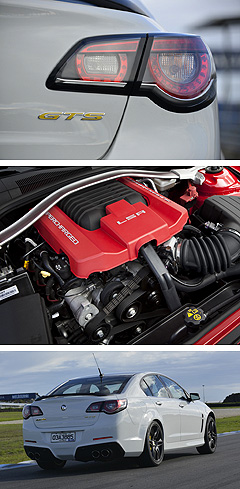Power wars over, says HSV’s Harding
BY BARRY PARK | 7th Jun 2013

The go-fast arm of Holden used to pride itself on incremental upgrades to power over the life of a vehicle range, but that has now fallen to the rising cost of extracting even small amounts of extra poke at the rear wheels.
“I don't need to keep outdoing myself each year, and since the E-Series upgrade was launched the progress of power increases has been slower than it has in the previous 20 years,” Mr Harding told GoAuto at this week’s launch of the most powerful range of HSV cars yet.
His words mean this range of HSV vehicles could be the last of the big-horsepower cars developed in Australia, after its Gen-F series of cars that go on sale this week added a supercharged 6.2-litre “LSA” engine to its line-up that produces 430kW of power and a stump-pulling 740Nm of torque.
It sits alongside the normally aspirated 6.2-litre V8 engine that borrows some bits from the LSA engine – but not the supercharger – to produce a still-healthy 340kW and 570Nm, well up on the default 325kW and 550Nm.
Mr Harding said it was starting to cost him the same amount of money to tweak an engine for 5kW as it would for 50kW, making incremental increases unviable.

“You're going through the same hurdles (to add small amounts of power and torque) -- certification, homologation, development, testing – and it's just becoming hugely expensive,” Mr Harding said.
“So the little bits and pieces that you used to do every year though our previous E-Series, you'll notice we've stopped doing that.”Mr Harding said the 340kW engine tune for the 6.2-litre LS3 engine was an unintended bonus of the supercharged LSA engine’s development program.
“And the 340kW has come to us as a tremendous surprise, but it came to us as a result of the GTS development because, as you know, we put the breathing package from the GTS on the standard engine.
“As soon as we put it on the standard engine we got 340kW,” he said.
“We sat around at a meeting one day and said ‘Well, we've got to go for that, hadn't we?’ “So we did it.”Mr Harding said he thought HSV had already stretched the boundary with its 325kW LS3 engine development.
“We thought we were at the limit – not the ultimate limit, but the legal limit ... where you get an engine tune that complies with ADRs (Australian Design Rules),” he said.
“It’s where you can add a few more kilowatts, or maybe only a fraction more (to still stay within the confines of the ADRs), so when 340kW came along, it was quite a surprise.” Mr Harding said he then sold the LSA idea to parent company Holden by fitting an engine crated in from the US under the bonnet of a car that the current Gen-Y replaces.
“Everyone at Holden who drove it liked it as much as we did,” he said.
There are no indications that HSV arch-rival Ford Performance Vehicles is planning to outgun the 430kW supercharged V8 in the GTS flagship with a reborn Falcon GTHO.
As GoAuto has reported, a cloud hangs over the future of the FPV operations with the announcement that Ford will cease manufacturing in Australia from 2016, although an upgraded FPV series is due next year with the final Falcon range.
The current FPV GT uses a 335kW/570Nm supercharged 5.0-litre ‘Miami’ V8.